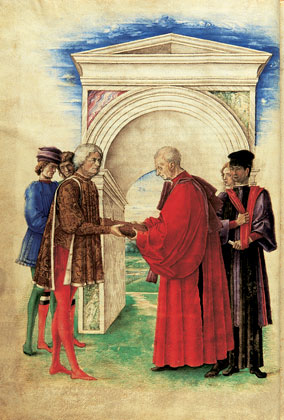Andrea Mantegna and Giovanni Bellini
In 1453, Mantegna married Nicolosia, Giovanni Bellini’s sister, thus forming close links with the most important painting workshop in Venice, run by his father-in-law Jacopo Bellini. The intense exchanges of ideas between the two brothers-in-law and the resulting influences were to have fundamental repercussions on the destinies of painting in Northern Italy.
Of the different figures making up the Saint Luke altarpiece, undertaken by Mantegna in 1453, the Saint Justina shows best Giovanni Bellini’s tender vein, as does the Virgin and Child with two saints whose style places it in the same period.
If Jacopo remains faithful to his visionary landscapes, to the late Gothic world, Giovanni shows himself, early on, receptive to Donatello’s art, for example in the predella relating episodes of the life of Drusiana. The miniatures of the Passion of Saint Maurice, Strabo’s Geography and of the Madonna of Pavia also show Mantegna’s ascendancy, but this was to be short-lived. As from 1460, with the moving Blessing Christ which, with its brilliant matter and pathetic inspiration, testifies the seduction exercised by the Flemish masters, in particular Rogier van der Weyden, Giovanni is in complete possession of a personal style
Giovanni Bellini (Venice, circa 1430 - Venice, 1516)
Guarino of Verona Consigns His Translation of Strabo to Jacopo Antonio Marcello
1459
Distemper on vellum; H. 37 cm; W. 25 cm
Albi, Médiathèque municipale Pierre - Amalric, RES.MS 77 : folio 3v°
© Médiathèque et bibliothèques municipales, Albi










